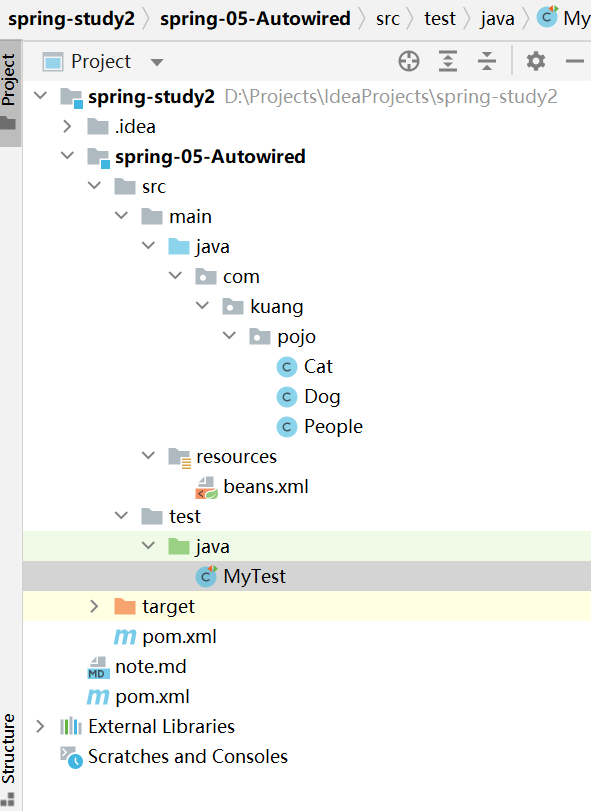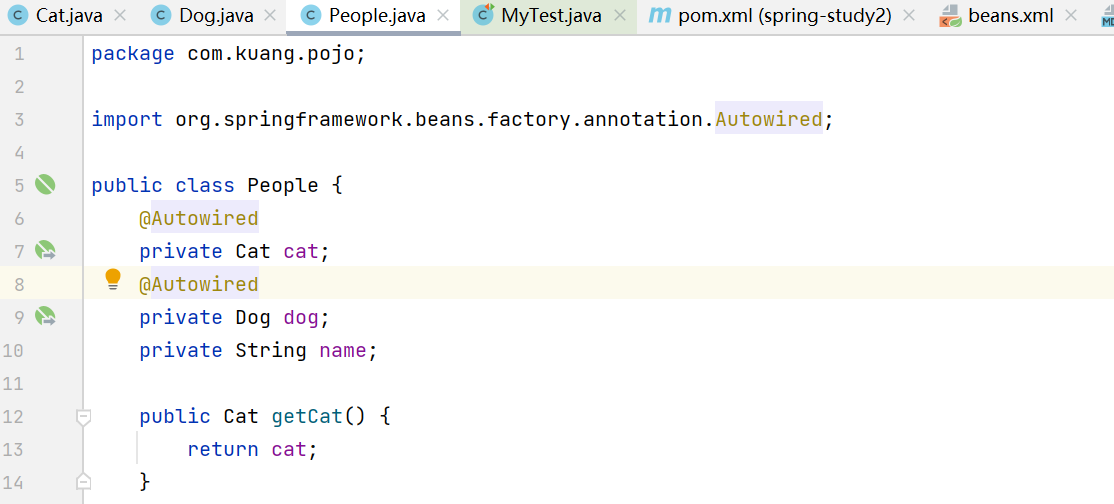Spring5-7
熟悉spring:
项目结构如下:

spring-study2的pom.xml文件中添加以下依赖:
<!-- https://mvnrepository.com/artifact/org.springframework/spring-webmvc --> <dependency> <groupId>org.springframework</groupId> <artifactId>spring-webmvc</artifactId> <version>5.3.17</version> </dependency> <!-- https://mvnrepository.com/artifact/junit/junit --> <dependency> <groupId>junit</groupId> <artifactId>junit</artifactId> <version>4.13.1</version> <scope>test</scope> </dependency>
Cat类如下:
package com.kuang.pojo; public class Cat { public void shout(){ System.out.println("miao~"); } }
Dog类如下:
package com.kuang.pojo; public class Dog { public void shout(){ System.out.println("wang~"); } }
People类如下:
package com.kuang.pojo; public class People { private Cat cat; private Dog dog; private String name; public Cat getCat() { return cat; } public Dog getDog() { return dog; } public String getName() { return name; } public void setCat(Cat cat) { this.cat = cat; } public void setDog(Dog dog) { this.dog = dog; } public void setName(String name) { this.name = name; } @Override public String toString() { return "People{" + "cat=" + cat + ", dog=" + dog + ", name='" + name + '\'' + '}'; } }
MyTest类如下:
import com.kuang.pojo.People; import org.junit.Test; import org.springframework.context.ApplicationContext; import org.springframework.context.support.ClassPathXmlApplicationContext; public class MyTest { @Test public void test1(){ ApplicationContext context = new ClassPathXmlApplicationContext("beans.xml"); People people = context.getBean("people",People.class); people.getCat().shout(); people.getDog().shout(); } }
beans.xml添加如下:
<bean id="dog" class="com.kuang.pojo.Dog"/> <bean id="cat" class="com.kuang.pojo.Cat"/> <bean id="people" class="com.kuang.pojo.People"> <property name="name" value="陆迁加油呀~"/> <property name="cat" ref="cat"/> <property name="dog" ref="dog"/> </bean>
使用注解自动装配:
1.导入约束:context约束
2.配置注解的支持:context:annotation-config【重要!】
<?xml version="1.0" encoding="UTF-8"?> <beans xmlns="http://www.springframework.org/schema/beans" xmlns:xsi="http://www.w3.org/2001/XMLSchema-instance" xmlns:context="http://www.springframework.org/schema/context" xsi:schemaLocation="http://www.springframework.org/schema/beans http://www.springframework.org/schema/beans/spring-beans.xsd http://www.springframework.org/schema/context http://www.springframework.org/schema/context/spring-context.xsd"> <!--开启注解的支持--> <context:annotation-config/> <bean id="cat" class="com.kuang.pojo.Cat"/> <bean id="dog" class="com.kuang.pojo.Dog"/> <bean id="people" class="com.kuang.pojo.People"/> </beans>
在People类做添加@Autowired,也可以删掉此类中的set方法:

@Autowired
使用Autowired我们可以不用编写set方法,前提是你这个自动装配的属性在IOC(Spring)容器中存在,且符合byType!
注解说明
- @Autowired:自动装配通过类型。名字
- 如果Autowired不能唯一自动装配上属性,则需要通过@Qualifier(value="xxx")
- @Nullable:字段标记了这个注解,说明这个字段可以为null
- @Resource:自动装配通过名字。类型
__EOF__
本文作者:techgy
本文链接:https://www.cnblogs.com/techgy/p/16085947.html
关于博主:I am a good person
版权声明:本博客所有文章除特别声明外,均采用 BY-NC-SA 许可协议。转载请注明出处!
声援博主:如果您觉得文章对您有帮助,可以点击文章右下角【推荐】一下。您的鼓励是博主的最大动力!
本文链接:https://www.cnblogs.com/techgy/p/16085947.html
关于博主:I am a good person
版权声明:本博客所有文章除特别声明外,均采用 BY-NC-SA 许可协议。转载请注明出处!
声援博主:如果您觉得文章对您有帮助,可以点击文章右下角【推荐】一下。您的鼓励是博主的最大动力!




【推荐】国内首个AI IDE,深度理解中文开发场景,立即下载体验Trae
【推荐】编程新体验,更懂你的AI,立即体验豆包MarsCode编程助手
【推荐】抖音旗下AI助手豆包,你的智能百科全书,全免费不限次数
【推荐】轻量又高性能的 SSH 工具 IShell:AI 加持,快人一步
· TypeScript + Deepseek 打造卜卦网站:技术与玄学的结合
· Manus的开源复刻OpenManus初探
· AI 智能体引爆开源社区「GitHub 热点速览」
· 从HTTP原因短语缺失研究HTTP/2和HTTP/3的设计差异
· 三行代码完成国际化适配,妙~啊~